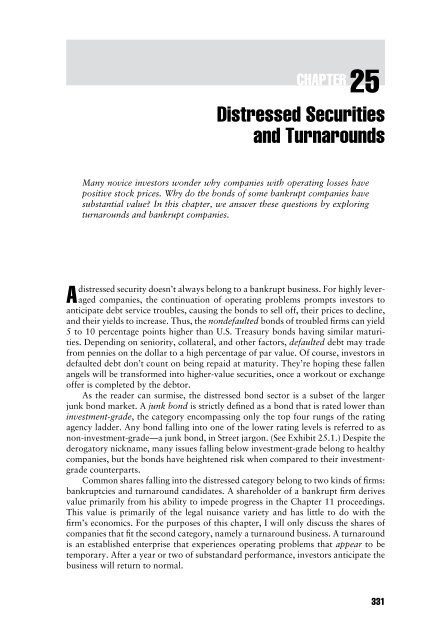- Page 3 and 4:
Security A
- Page 5 and 6:
Security A
- Page 7 and 8:
ContentsPrefaceWhat Is Secu
- Page 9 and 10:
ContentsviiCHAPTER 7Company-Specifi
- Page 11 and 12:
ContentsixCase Study: Keane, Inc. 2
- Page 13:
ContentsxiCHAPTER 27The Emerging Ma
- Page 16 and 17:
xivPREFACEmajor contributing factor
- Page 18 and 19:
xviPREFACEImpact of two market cras
- Page 20 and 21:
xviiiPREFACEOVERVIEW OF THE CONTENT
- Page 22 and 23:
xxPREFACECAPM and
- Page 25 and 26:
CHAPTER 1Why Analyze a Secu
- Page 27 and 28:
WhyAnalyzeaSecurity</strong
- Page 29 and 30:
WhyAnalyzeaSecurity</strong
- Page 31 and 32:
WhyAnalyzeaSecurity</strong
- Page 33 and 34:
WhyAnalyzeaSecurity</strong
- Page 35 and 36:
WhyAnalyzeaSecurity</strong
- Page 37 and 38:
WhyAnalyzeaSecurity</strong
- Page 39 and 40:
CHAPTER 2Who’s Practicing <strong
- Page 41 and 42:
Who’s Practicing Security
- Page 43 and 44:
Who’s Practicing Security
- Page 45 and 46:
Who’s Practicing Security
- Page 47 and 48:
Who’s Practicing Security
- Page 49 and 50:
Who’s Practicing Security
- Page 51 and 52:
CHAPTER 3Seeking a Level Playing Fi
- Page 53 and 54:
Seeking a Level Playing Field 31Man
- Page 55 and 56:
Seeking a Level Playing Field 33gat
- Page 57 and 58:
Seeking a Level Playing Field 35EXH
- Page 59 and 60:
Seeking a Level Playing Field 37Fur
- Page 61 and 62:
Seeking a Level Playing Field 39inv
- Page 63 and 64:
Seeking a Level Playing Field 41EXH
- Page 65 and 66:
Seeking a Level Playing Field 43EXH
- Page 67 and 68:
Seeking a Level Playing Field 4563
- Page 69 and 70:
Seeking a Level Playing Field 47EXH
- Page 71 and 72:
Seeking a Level Playing Field 49Ini
- Page 73 and 74:
CHAPTER 4Other Sources of Informati
- Page 75 and 76:
Other Sources of Information 53pres
- Page 77 and 78:
Other Sources of Information 55inve
- Page 79:
Other Sources of Information 57they
- Page 83 and 84:
CHAPTER 5Starting the Analy
- Page 85 and 86:
Starting the Analysis</stro
- Page 87 and 88:
Starting the Analysis</stro
- Page 89 and 90:
Starting the Analysis</stro
- Page 91 and 92:
Starting the Analysis</stro
- Page 93:
Starting the Analysis</stro
- Page 96 and 97:
74 PERFORMING THE ANALYSIS AND WRIT
- Page 98 and 99:
76 PERFORMING THE ANALYSIS AND WRIT
- Page 100 and 101:
78 PERFORMING THE ANALYSIS AND WRIT
- Page 102 and 103:
80 PERFORMING THE ANALYSIS AND WRIT
- Page 104 and 105:
82 PERFORMING THE ANALYSIS AND WRIT
- Page 106 and 107:
84 PERFORMING THE ANALYSIS AND WRIT
- Page 108 and 109:
86 PERFORMING THE ANALYSIS AND WRIT
- Page 110 and 111:
88 PERFORMING THE ANALYSIS AND WRIT
- Page 112 and 113:
90 PERFORMING THE ANALYSIS AND WRIT
- Page 114 and 115:
92 PERFORMING THE ANALYSIS AND WRIT
- Page 116 and 117:
94 PERFORMING THE ANALYSIS AND WRIT
- Page 118 and 119:
96 PERFORMING THE ANALYSIS AND WRIT
- Page 120 and 121:
98 PERFORMING THE ANALYSIS AND WRIT
- Page 122 and 123:
100 PERFORMING THE ANALYSIS AND WRI
- Page 124 and 125:
102 PERFORMING THE ANALYSIS AND WRI
- Page 126 and 127:
104 PERFORMING THE ANALYSIS AND WRI
- Page 128 and 129:
106 PERFORMING THE ANALYSIS AND WRI
- Page 130 and 131:
108 PERFORMING THE ANALYSIS AND WRI
- Page 132 and 133:
110 PERFORMING THE ANALYSIS AND WRI
- Page 134 and 135:
112 PERFORMING THE ANALYSIS AND WRI
- Page 136 and 137:
114 PERFORMING THE ANALYSIS AND WRI
- Page 138 and 139:
116 PERFORMING THE ANALYSIS AND WRI
- Page 140 and 141:
118 PERFORMING THE ANALYSIS AND WRI
- Page 142 and 143:
120 PERFORMING THE ANALYSIS AND WRI
- Page 144 and 145:
122 PERFORMING THE ANALYSIS AND WRI
- Page 146 and 147:
124 PERFORMING THE ANALYSIS AND WRI
- Page 148 and 149:
126 PERFORMING THE ANALYSIS AND WRI
- Page 150 and 151:
128 PERFORMING THE ANALYSIS AND WRI
- Page 152 and 153:
130 PERFORMING THE ANALYSIS AND WRI
- Page 154 and 155:
132 PERFORMING THE ANALYSIS AND WRI
- Page 156 and 157:
134 PERFORMING THE ANALYSIS AND WRI
- Page 158 and 159:
136 PERFORMING THE ANALYSIS AND WRI
- Page 161 and 162:
CHAPTER 9The Limitations of Account
- Page 163 and 164:
The Limitations of Accounting Data
- Page 165 and 166:
The Limitations of Accounting Data
- Page 167 and 168:
The Limitations of Accounting Data
- Page 169 and 170:
The Limitations of Accounting Data
- Page 171 and 172:
The Limitations of Accounting Data
- Page 173 and 174:
The Limitations of Accounting Data
- Page 175 and 176:
The Limitations of Accounting Data
- Page 177 and 178:
The Limitations of Accounting Data
- Page 179 and 180:
The Limitations of Accounting Data
- Page 181 and 182:
The Limitations of Accounting Data
- Page 183 and 184:
The Limitations of Accounting Data
- Page 185:
The Limitations of Accounting Data
- Page 188 and 189:
166 PERFORMING THE ANALYSIS AND WRI
- Page 190 and 191:
168 PERFORMING THE ANALYSIS AND WRI
- Page 192 and 193:
170 PERFORMING THE ANALYSIS AND WRI
- Page 194 and 195:
172 PERFORMING THE ANALYSIS AND WRI
- Page 196 and 197:
174 PERFORMING THE ANALYSIS AND WRI
- Page 198 and 199:
176 PERFORMING THE ANALYSIS AND WRI
- Page 200 and 201:
178 PERFORMING THE ANALYSIS AND WRI
- Page 202 and 203:
180 PERFORMING THE ANALYSIS AND WRI
- Page 204 and 205:
182 PERFORMING THE ANALYSIS AND WRI
- Page 206 and 207:
184 PERFORMING THE ANALYSIS AND WRI
- Page 208 and 209:
186 PERFORMING THE ANALYSIS AND WRI
- Page 210 and 211:
188 PERFORMING THE ANALYSIS AND WRI
- Page 212 and 213:
190 PERFORMING THE ANALYSIS AND WRI
- Page 214 and 215:
192 PERFORMING THE ANALYSIS AND WRI
- Page 217 and 218:
CHAPTER 12Valuation</strong
- Page 219 and 220:
Valuation Methodol
- Page 221 and 222:
CHAPTER 13Intrinsic Value a
- Page 223 and 224:
Intrinsic Value and</strong
- Page 225 and 226:
Intrinsic Value and</strong
- Page 227 and 228:
Intrinsic Value and</strong
- Page 229 and 230:
Intrinsic Value and</strong
- Page 231 and 232:
CHAPTER 14Discounted Cash Flow:Choo
- Page 233 and 234:
Discounted Cash Flow: Choosing the
- Page 235 and 236:
Discounted Cash Flow: Choosing the
- Page 237:
Discounted Cash Flow: Choosing the
- Page 240 and 241:
218 VALUATION AND THE INVESTMENT DE
- Page 242 and 243:
220 VALUATION AND THE INVESTMENT DE
- Page 244 and 245:
222 VALUATION AND THE INVESTMENT DE
- Page 246 and 247:
224 VALUATION AND THE INVESTMENT DE
- Page 248 and 249:
226 VALUATION AND THE INVESTMENT DE
- Page 250 and 251:
228 VALUATION AND THE INVESTMENT DE
- Page 252 and 253:
230 VALUATION AND THE INVESTMENT DE
- Page 254 and 255:
232 VALUATION AND THE INVESTMENT DE
- Page 256 and 257:
234 VALUATION AND THE INVESTMENT DE
- Page 258 and 259:
236 VALUATION AND THE INVESTMENT DE
- Page 260 and 261:
238 VALUATION AND THE INVESTMENT DE
- Page 262 and 263:
240 VALUATION AND THE INVESTMENT DE
- Page 265 and 266:
CHAPTER 18Sum-of-the-Parts
- Page 267 and 268:
Sum-of-the-Parts Analysis</
- Page 269 and 270:
Sum-of-the-Parts Analysis</
- Page 271 and 272:
Sum-of-the-Parts Analysis</
- Page 273:
Sum-of-the-Parts Analysis</
- Page 276 and 277:
254 VALUATION AND THE INVESTMENT DE
- Page 278 and 279:
256 VALUATION AND THE INVESTMENT DE
- Page 280 and 281:
258 VALUATION AND THE INVESTMENT DE
- Page 282 and 283:
260 VALUATION AND THE INVESTMENT DE
- Page 284 and 285:
262 VALUATION AND THE INVESTMENT DE
- Page 286 and 287:
264 VALUATION AND THE INVESTMENT DE
- Page 288 and 289:
266 VALUATION AND THE INVESTMENT DE
- Page 291 and 292:
CHAPTER 20Private EquityThous<stron
- Page 293 and 294:
Private Equity 2712 percent of comm
- Page 295 and 296:
Private Equity 273EXHIBIT 20.2 True
- Page 297 and 298:
Private Equity 275in public compani
- Page 299:
Private Equity 277EXHIBIT 20.7 Prem
- Page 302 and 303: 280 SPECIAL CASES4. Management’s
- Page 304 and 305: 282 SPECIAL CASESEXHIBIT 21.3 Encor
- Page 306 and 307: 284 SPECIAL CASESEXHIBIT 21.4(Conti
- Page 308 and 309: 286 SPECIAL CASESPipelinesPumpsSurf
- Page 310 and 311: 288 SPECIAL CASESEXHIBIT 21.9Encore
- Page 312 and 313: 290 SPECIAL CASESEXHIBIT 21.12Ranki
- Page 314 and 315: 292 SPECIAL CASESEXHIBIT 21.13Anglo
- Page 316 and 317: 294 SPECIAL CASESsince such actions
- Page 318 and 319: 296 SPECIAL CASESEXHIBIT 22.1The Fi
- Page 320 and 321: 298 SPECIAL CASESTWO SETS OF SKILLS
- Page 322 and 323: 300 SPECIAL CASESIn part, a financi
- Page 324 and 325: 302 SPECIAL CASESA quick glance at
- Page 326 and 327: 304 SPECIAL CASESEXHIBIT 22.12 Capi
- Page 328 and 329: 306 SPECIAL CASESEXHIBIT 22.14 J.P.
- Page 331 and 332: CHAPTER 23Insurance CompaniesInsura
- Page 333 and 334: Insurance Companies 311PRINCIPAL FU
- Page 335 and 336: Insurance Companies 313FINANCIAL ST
- Page 337 and 338: Insurance Companies 315competitive
- Page 339 and 340: Insurance Companies 317EXHIBIT 23.6
- Page 341 and 342: Insurance Companies 319EXHIBIT 23.8
- Page 343 and 344: CHAPTER 24Highly Speculative Stocks
- Page 345 and 346: Highly Speculative Stocks 323EXHIBI
- Page 347 and 348: Highly Speculative Stocks 325Gross
- Page 349 and 350: Highly Speculative Stocks 327his Ba
- Page 351: Highly Speculative Stocks 329Step 3
- Page 355 and 356: Distressed Securities and</
- Page 357 and 358: Distressed Securities and</
- Page 359 and 360: Distressed Securities and</
- Page 361 and 362: Distressed Securities and</
- Page 363 and 364: Distressed Securities and</
- Page 365 and 366: CHAPTER 26International StocksIn an
- Page 367 and 368: International Stocks 345EXHIBIT 26.
- Page 369 and 370: International Stocks 347EXHIBIT 26.
- Page 371 and 372: International Stocks 349DiscountRat
- Page 373 and 374: CHAPTER 27The Emerging MarketsIn th
- Page 375 and 376: The Emerging Markets 353The stock m
- Page 377 and 378: The Emerging Markets 355EXHIBIT 27.
- Page 379 and 380: The Emerging Markets 357Political R
- Page 381 and 382: The Emerging Markets 359To ensure l
- Page 383 and 384: The Emerging Markets 361EXHIBIT 27.
- Page 385 and 386: The Emerging Markets 363EXHIBIT 27.
- Page 387 and 388: The Emerging Markets 365EXHIBIT 27.
- Page 389: PARTFiveIn ConclusionChapter 28Chap
- Page 392 and 393: 370 IN CONCLUSIONand</stron
- Page 394 and 395: 372 IN CONCLUSIONGovernment Regulat
- Page 396 and 397: 374 IN CONCLUSIONwas credit driven,
- Page 398 and 399: 376 IN CONCLUSIONEXHIBIT 28.1 Finan
- Page 400 and 401: 378 IN CONCLUSIONEXHIBIT 28.2<stron
- Page 402 and 403:
380 IN CONCLUSIONmarket declines by
- Page 404 and 405:
382 IN CONCLUSIONthis morass of con
- Page 406 and 407:
384 NOTESCHAPTER 11Financial Projec
- Page 409 and 410:
IndexA. H. Belo, 158, 346Aaker, Dav
- Page 411 and 412:
Index 389EAC value per share on, 28
- Page 413 and 414:
Index 391Corning, 106Corporate advi
- Page 415 and 416:
Index 393target equity returns by c
- Page 417 and 418:
Index 395Fur retailing industry, 81
- Page 419 and 420:
Index 397“Insurance Underwriting
- Page 421 and 422:
Index 399Manulife, Inc., 319Margin,
- Page 423 and 424:
Index 401Pakistan, 351Palmisano, Sa
- Page 425 and 426:
Index 403Recreation sector, 76Redwo
- Page 427 and 428:
Index 405Sell-side reports, 62Semic
- Page 429 and 430:
Index 407practices, emerging market
- Page 431:
Praise for the First Edition“A we
















